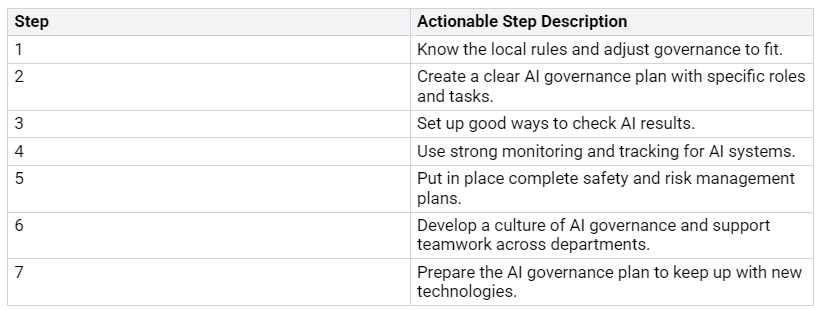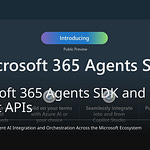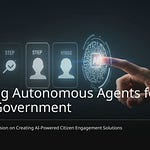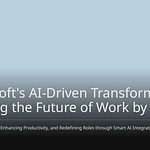Building governance for AI agents is crucial in today’s landscape. Without a solid plan, your organization faces significant risks. For instance, only 35% of companies have a formal AI governance plan in place. This lack of control can lead to serious problems, as AI agents might inadvertently access sensitive data or share it with unauthorized individuals. More than 80% of organizations utilizing AI agents have reported challenges such as unauthorized access and accidental data leaks. Establishing a clear governance framework not only helps mitigate these risks but also lays a strong foundation for effectively leveraging AI.
Key Takeaways
Make a clear plan for AI governance. This helps lower risks and keeps sensitive data safe.
Use control towers to watch AI agents all the time. This helps enforce clear rules.
Set clear roles and responsibilities in your AI governance plan. This makes sure everyone is accountable.
Keep checking regularly to find compliance problems early. This stops them from getting worse.
Build a culture of AI governance. This should support teamwork and adjust to new technologies.
Importance of AI Governance
AI agents can change your business for the better. They help you work faster and make quick decisions. But without good rules, you risk a lot. If AI is not controlled, it can cause problems that hurt your business.
Risks of Unregulated AI
AI agents are being used quickly, but rules are not keeping up. This creates confusion about what could go wrong. You might not know all the dangers of using AI without rules. For example, the Equal Employment Opportunity Commission (EEOC) says companies must be responsible for AI used in hiring. Also, big insurance companies are facing lawsuits for using technology to deny claims.
Look at these worrying numbers:
More than half (56%) of US workers use generative AI at work.
Only 10% of companies have a formal policy for generative AI.
These numbers show we need rules now. AI has caused big problems in many fields. For instance, biased resume checks in hiring and mistakes in healthcare show what can happen without rules.
Also, many employees use AI tools without permission. A huge 91% of workers think there is little risk when using these tools. In fact, 60% say they use unapproved AI tools more than last year. This makes it hard to keep track of security, as many of these tools are online services.
Shadow AI brings more problems with data privacy and automated choices. These issues are different from regular shadow IT, which is mainly about unapproved software.
The Role of Control Towers
Control towers are very important for AI governance. They help keep an eye on things and reduce risks with AI agents. Here’s how they work:
By using control towers, you can change AI agents from just reporting to giving real-time insights. This change helps you respond quickly to problems. AI agents can check risks and suggest solutions, leading to faster responses and fewer issues.
Building Governance Frameworks
Making a strong governance framework is very important for managing AI agents well. You can do this by focusing on two main things: centralized visibility and defined roles and responsibilities.
Centralized Visibility
Centralized visibility is key to making your AI governance framework work better. When you can see all AI models and what they do, you can make smart choices quickly. Here are some important benefits of centralized visibility:
Improved Oversight: A centralized system helps you keep track of all AI agents in one spot. This way, you can find risks and compliance problems early.
Holistic View: A single AI model registry gives you a full list of AI models. This complete view helps everyone understand the whole model collection, which improves decision-making.
Streamlined Processes: Organizations that use centralized visibility see an 80% boost in AI oversight efficiency. This improvement leads to better governance and faster responses to problems.
By having centralized visibility, you can grow your AI projects responsibly while reducing operational and compliance risks.
Defined Roles and Responsibilities
Clearly defining roles and responsibilities is another key part of good AI governance. When everyone knows their jobs, you can create accountability and make sure your AI agents follow the rules. Here are some important roles for your governance framework:
Setting up these roles helps you create a clear environment where teams can manage AI risks well. Writing down roles makes sure everyone involved in AI governance knows their tasks. This clarity leads to better results, like improved compliance and performance.
Adding these best practices to your governance framework will help you connect AI projects with your organization’s goals. You can also use these strategies to make your framework stronger:
Define AI Governance Policies: Set rules for fairness, accountability, and transparency.
Establish AI Governance Teams: Create a group with different roles to oversee AI strategy and compliance.
Integrate AI Risk Management: Find risk factors and use monitoring tools.
AI Explainability & Documentation: Build models that explain their reasoning and keep audit logs.
Continuous AI Model Monitoring: Use tools to check performance and create feedback loops.
Secure & Comply with AI Regulations: Use security frameworks and follow relevant regulations.
By focusing on centralized visibility and defined roles, you can create a governance framework that reduces risks and helps your organization innovate safely with AI agents.
Monitoring and Compliance
Monitoring and compliance are very important for managing AI agents well. You need to have mandatory monitoring to make sure your AI systems follow the rules. This helps you find risks and compliance problems before they become serious.
Mandatory Monitoring
Continuous monitoring systems are key in industries with strict rules. They help you stay compliant with standards like HIPAA. These systems let you fix compliance issues and ensure accuracy in healthcare. Here are some important monitoring methods to think about:
By using these methods, you can improve your oversight of AI agents and make sure they follow the governance rules.
Compliance Strategies
Having clear policies is very important for the reliability of AI agent work. You should focus on several compliance strategies to make sure your AI systems meet regulations. Here are some effective parts to think about:
These strategies help you follow the rules and support ongoing AI innovation. A strong governance framework reduces bias, encourages fairness, and ensures transparency in your AI projects. By using clear processes and regular checks, you can keep up with changing rules and what society expects.
Using Technology for Governance
Technology is very important for good governance of AI agents. By using advanced platforms, you can improve oversight and make integration easier. This method not only reduces risks but also encourages responsible use of AI.
Governance Control Towers
Governance control towers act as main centers for managing AI plans and rules. They give you a clear view of AI activities, helping you check risks better. Here are some main jobs of governance control towers:
Centralized Management: You can watch all AI agents from one place, making governance easier.
Risk Assessment: Control towers help you find possible risks before they get worse.
Innovation Facilitation: These towers let teams suggest new ideas while keeping control.
Control towers also solve common problems in AI governance. Many organizations have issues with scattered data, many models, and security worries. By bringing these parts together, you can greatly improve your governance framework.
Combining AI Tools
Combining AI governance tools with platforms like Microsoft 365 Admin Center boosts your organization’s ability to manage AI well. Here are some benefits of this combination:
By using these tools, you can make sure your AI systems work within ethical and legal limits. Regular checks and documentation will help you stay open and responsible.
Case Studies in AI Governance
Successful Implementations
Many companies have done a great job with AI governance. These examples show how good rules can lead to great results. Here are some important cases:
These companies have seen real improvements in how they work. For example, regular AI practice drills have helped them respond faster to problems. Weekly practice for shutting down AI systems has also made their response skills much better.
Lessons Learned
While many companies have done well, some have had problems. Here are some common mistakes to avoid when setting up AI governance:
Lack of Clarity: Without clear rules, AI governance can get confusing.
Metrics Misalignment: Not having clear measures can make governance weak and unclear.
Unclear Strategy: A clear plan is needed to prioritize tasks and use resources well.
Neglecting Data Quality: Starting an AI project without clean data can cause wrong predictions and failure.
Underestimating Change Management: Not preparing your team for AI can lead to pushback or poor use.
In one finance company, an internal AI helper found old compliance rules from a policy document that was outdated. Teams acted on this wrong info, causing a near-miss in compliance that took days to fix.
These lessons show how important it is to involve the community and keep a close watch on AI governance. Getting stakeholders involved can help match AI goals with what society needs, ensuring responsible growth.
A well-managed AI environment has many benefits for your organization. It reduces legal risks, builds trust, and makes operations run better. You can encourage new ideas while keeping your good name. Here are some steps to focus on:
By following these steps, you can mix productivity with responsibility. Focusing on governance in your AI plans will help you succeed in the long run and gain trust from stakeholders.
FAQ
What is AI governance?
AI governance is the set of rules and plans that guide how AI agents are used in a company. It helps make sure everything is done right, lowers risks, and keeps everyone responsible for AI actions.
Why is centralized visibility important?
Centralized visibility lets you watch all AI agents from one place. This helps you find risks, make sure rules are followed, and make smart choices quickly.
How can I implement AI governance in my organization?
Begin by clearly defining roles and responsibilities. Then, set up rules and use monitoring tools. Regular checks and getting input from others will also make your governance stronger.
What are control towers in AI governance?
Control towers are central places for managing AI work. They give real-time updates, enforce rules, and help communication between AI agents and people.
How does monitoring contribute to AI compliance?
Monitoring makes sure AI systems follow the set rules and laws. It helps you spot problems early, keep data safe, and support ongoing compliance efforts.

















